Spatial and Temporal Variability of Near-Surface CO2 and Influencing Factors in Urban Communities
Abstract
1. Introduction
- The mobile measurement allows for the study of highly fine-grained CO2 spatial distribution characteristics, yielding reliable, reproducible, and representative results [21]. A comparison of urban canopy cross sections and near-surface CO2 monitoring results indicated that urban CO2 emissions mainly stem from near-surface human activities [24], and the moving measurement is more adaptable for identifying the sources of CO2 at a height of 1–3 m above the ground [25].
2. Materials and Methods
2.1. The Framework of the Study
2.2. Sample Selection
2.3. CO2 Measurement Scheme
2.4. Measuring Methods
2.4.1. Measuring Instruments
2.4.2. Fixed and Mobile Measurements
- (1)
- Sample selection: five typical community types were selected through morphological cluster analysis.
- (2)
- Design of measurement points: Communities were divided into 20 m × 20 m grids. Points completely obstructed by buildings were excluded, resulting in the identification of 285 measurement points (29.8% of which were near roads). The grid centers were used as mobile measurement points, while fixed measurement points were located in the central open area of each community, suitable for 24 h instrument placement.
- (3)
- Data collection:
- Fixed measurements: instruments were placed at a height of 1.2 m, continuously recording CO2 concentrations for 24 h, with data collected at 10 min intervals.
- Mobile measurements: Conducted in four time periods each day (LT8–10, LT11–13, LT14–16, LT17–19) along preset routes. Each point was sampled for 30 s with the instrument, and all points were measured within approximately two hours [33].
- (4)
- Data calibration: All instruments were calibrated with standard gases prior to measurements. Cross-validation was conducted between mobile and fixed data, achieving an average measurement accuracy of 96.8%.
2.5. Data Analysis Methods
2.5.1. Space Influencing Indicators
- Distance to External Transportation (DO): shortest path from monitoring points to boundary roads of communities;
- Distance to Internal Streets (DS): Euclidean distance from monitoring points to community-level roads;
- Distance to Intersections (DI): topological distance from monitoring points to nearest road intersections.
2.5.2. Spearman Correlation Analysis
2.5.3. Random Forest Model
2.5.4. Geographically and Temporally Weighted Regression Model
3. Results
3.1. General Characteristics
3.2. Temporal Variability
3.3. Spatial Variability
4. Analysis of Spatial Influencing Factors
4.1. Correlation Between Spatial Influencing Factors and Near-Surface CO2 Levels
4.2. Contribution of Spatial Elements to Community Near-Surface CO2 Levels
4.3. Influence of Spatial Elements on the Spatial and Temporal Variability to Community Near-Surface CO2 Levels
5. Discussion
5.1. Spatiotemporal Pattern Typology
5.2. Differential Driver Mechanisms
5.3. Practical Mitigation Pathways
- (1)
- Optimization of spatial organization
- (2)
- Green landscape design and carbon sequestration enhancement
- (3)
- Policy guidelines and regulatory frameworks
5.4. Limitations
6. Conclusions
Author Contributions
Funding
Data Availability Statement
Conflicts of Interest
Abbreviations
| AH | Average Height |
| BA | Building Area |
| BD | Building Density |
| DB | Distance to Buildings |
| DI | Distance to the Intersection |
| DO | Distance to the Outer Road |
| DS | Distance to the community Street |
| ED | Enclosure Degree |
| FAR | Floor Area Ratio |
| GPS | Global Positioning System |
| GTWR | Geographically and Temporally Weighted Regression |
| GWR | Geographically Weighted Regression |
| LT | Local Time |
| MH | Max Height |
| NDIR | Non-Dispersive Infra-Red |
| OLS | Ordinary Least Square |
| OSR | Open Space Ratio |
| PA | Plot Area |
| PP | Plot Perimeter |
| RMA | Regression Moving Average |
| RF | Random Forest |
| TBA | Total Building Area |
Appendix A
Appendix A.1. Indicator Calculation
Appendix A.2. Data Acquisition
| Data Name | Data Content | Year | Data Sources | Application |
|---|---|---|---|---|
| Community Information Data | Housing Name, Year of Construction, Number of Households, Boundary | 2022 | China’s largest second-hand housing transaction website | Obtain boundaries and calculate plot indicators |
| Building Data | Building Area, Number of Floors | 2021 | Tianditu Platform | Morphological, density, and layout indicators |
| Green Space Data | Green Space Area Vector Outline | 2021 | Tianditu Platform | Calculate density indicators |
| Road Data | Road Centerline Vector | 2021 | Amap (Gaode Map) Platform | Correct community boundaries |
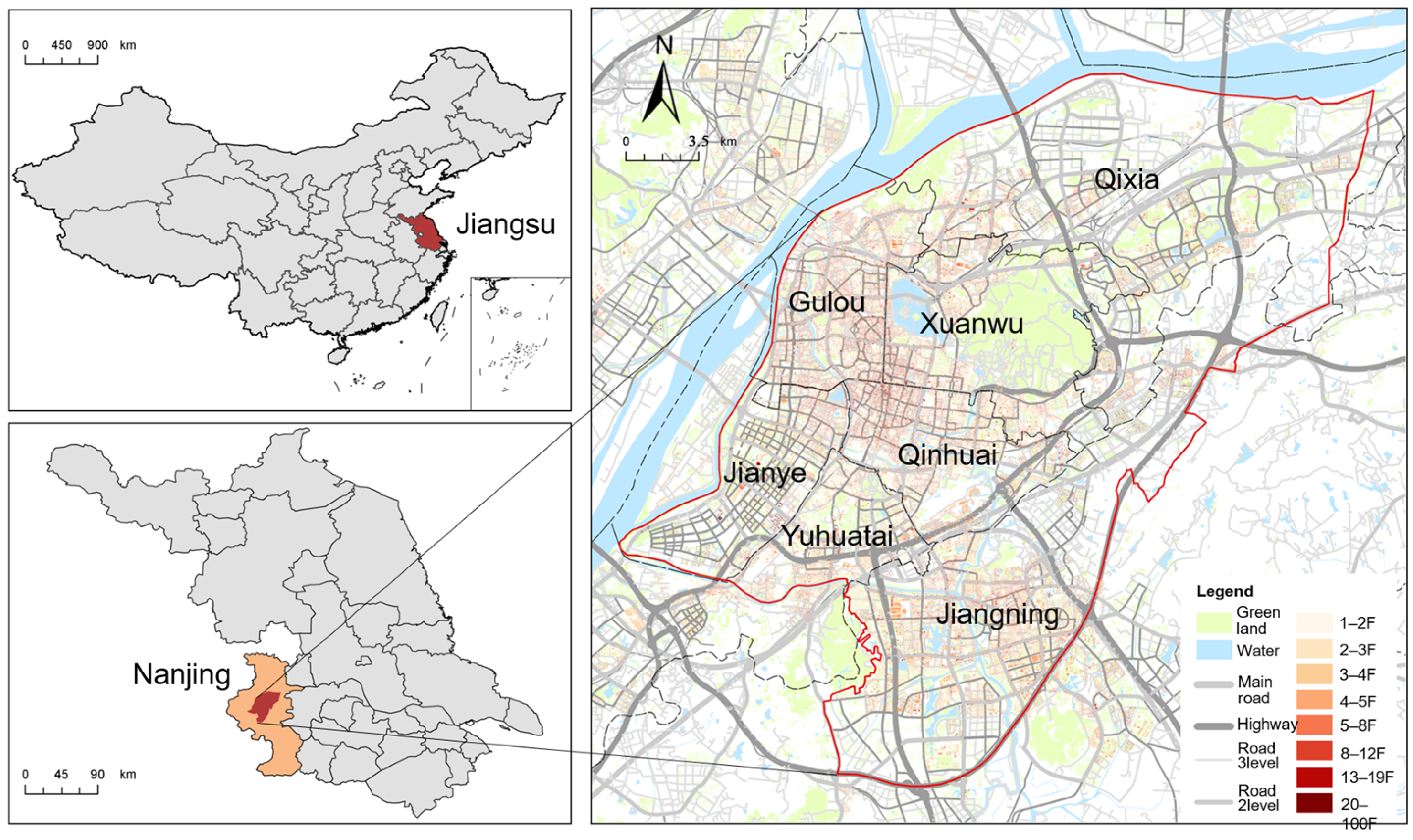
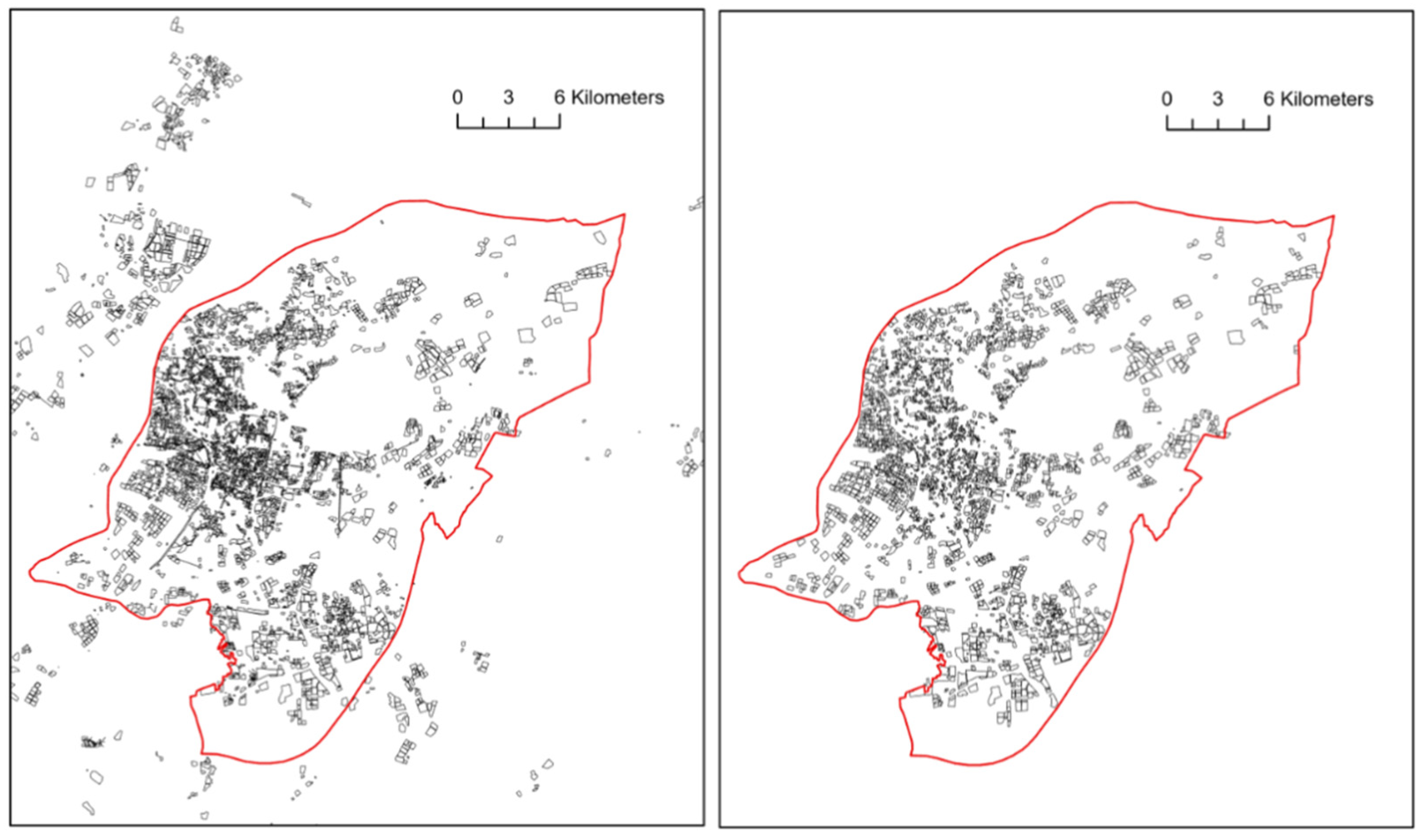
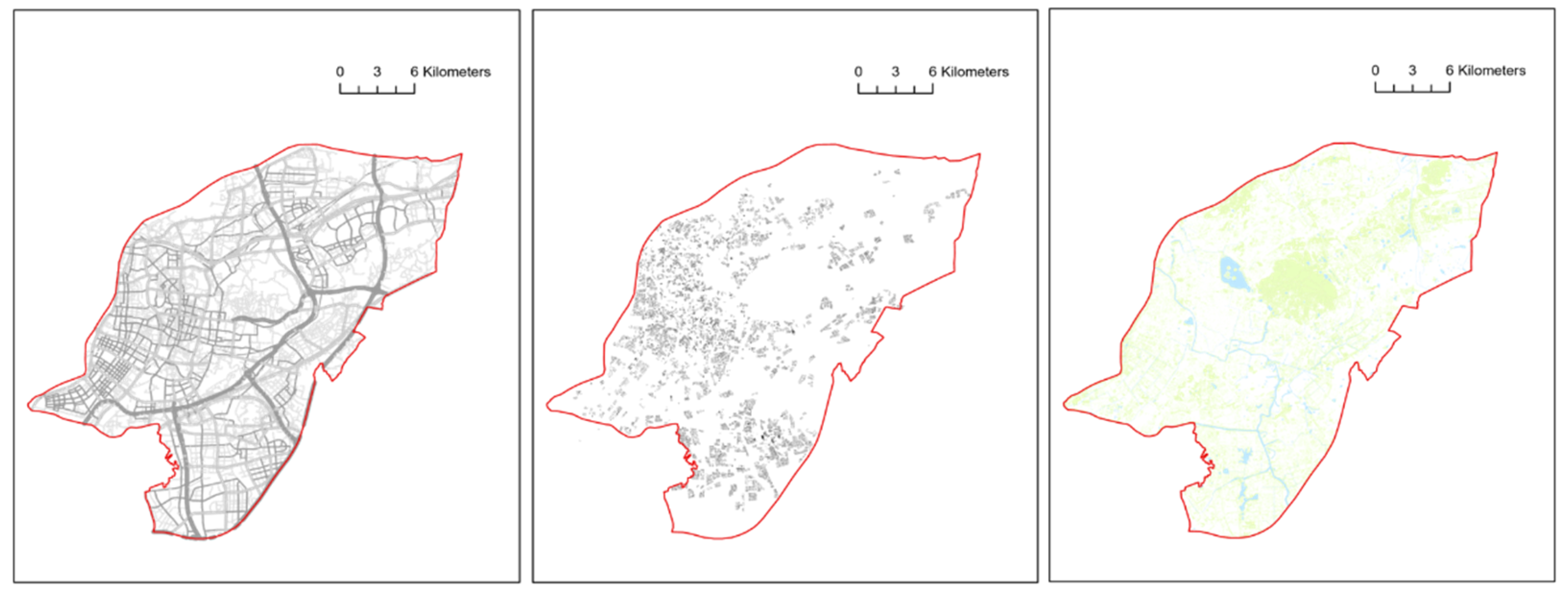
Appendix A.3. Clustering Methods and Results
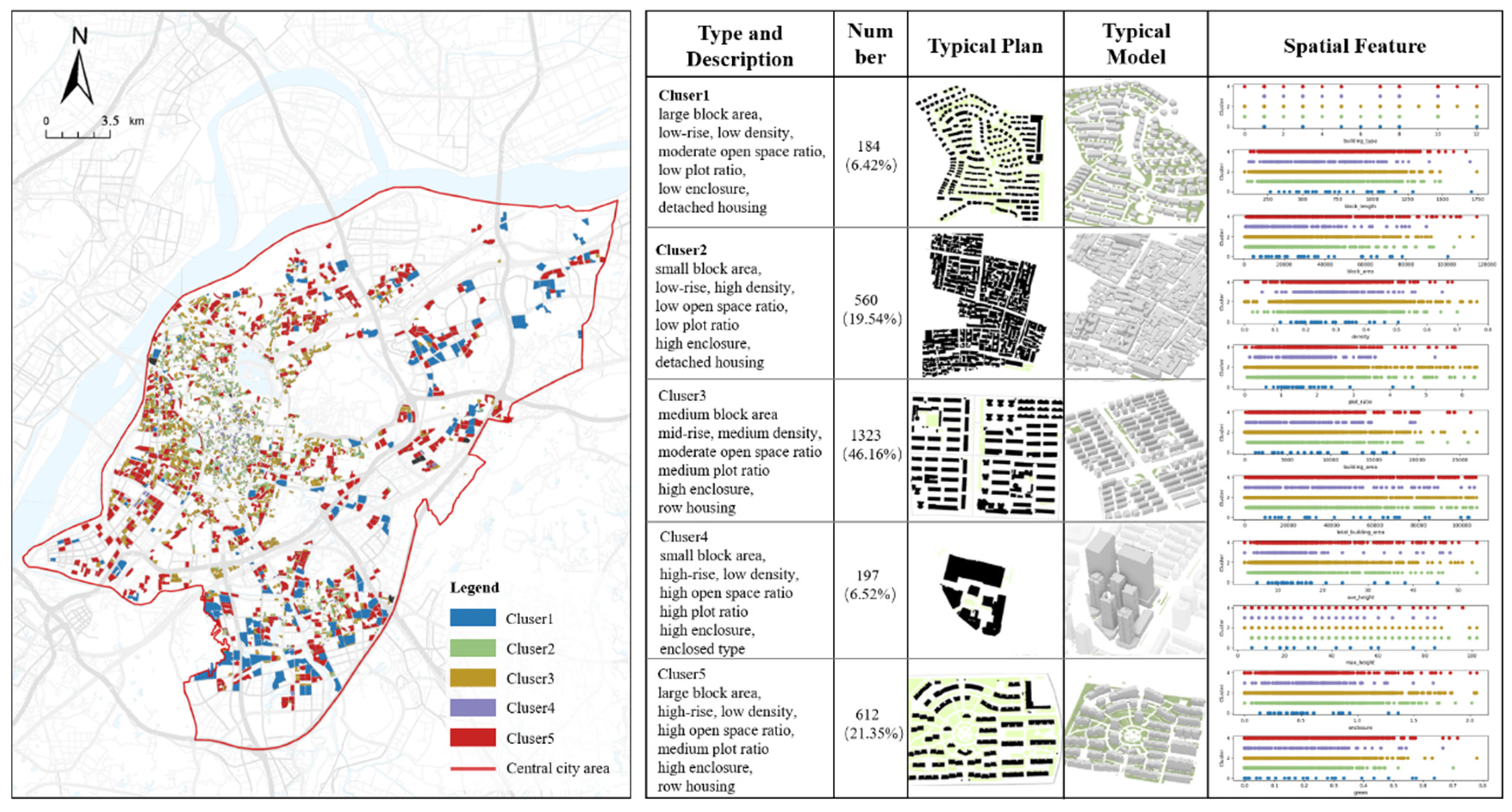
Appendix B
| Factors | ALL | Community A | Community B | Community C | Community D | Community E |
|---|---|---|---|---|---|---|
| DO | 0.256 | 0.390 | 0.220 | 0.479 | 0.182 | 0.201 |
| DS | 0.249 | 0.135 | 0.201 | 0.186 | 0.336 | 0.185 |
| DI | 0.209 | 0.249 | 0.247 | 0.154 | 0.345 | 0.366 |
| DB | 0.156 | 0.128 | 0.221 | 0.141 | 0.138 | 0.127 |
| GR | 0.130 | 0.099 | 0.111 | 0.040 | 0.000 | 0.121 |
| RMSE | 0.183 | 0.252 | 0.245 | 0.097 | 0.653 | 0.252 |
| R2 | 0.817 | 0.748 | 0.756 | 0.903 | 0.347 | 0.748 |
Appendix C
The Climatic Conditions on the Measurement Day

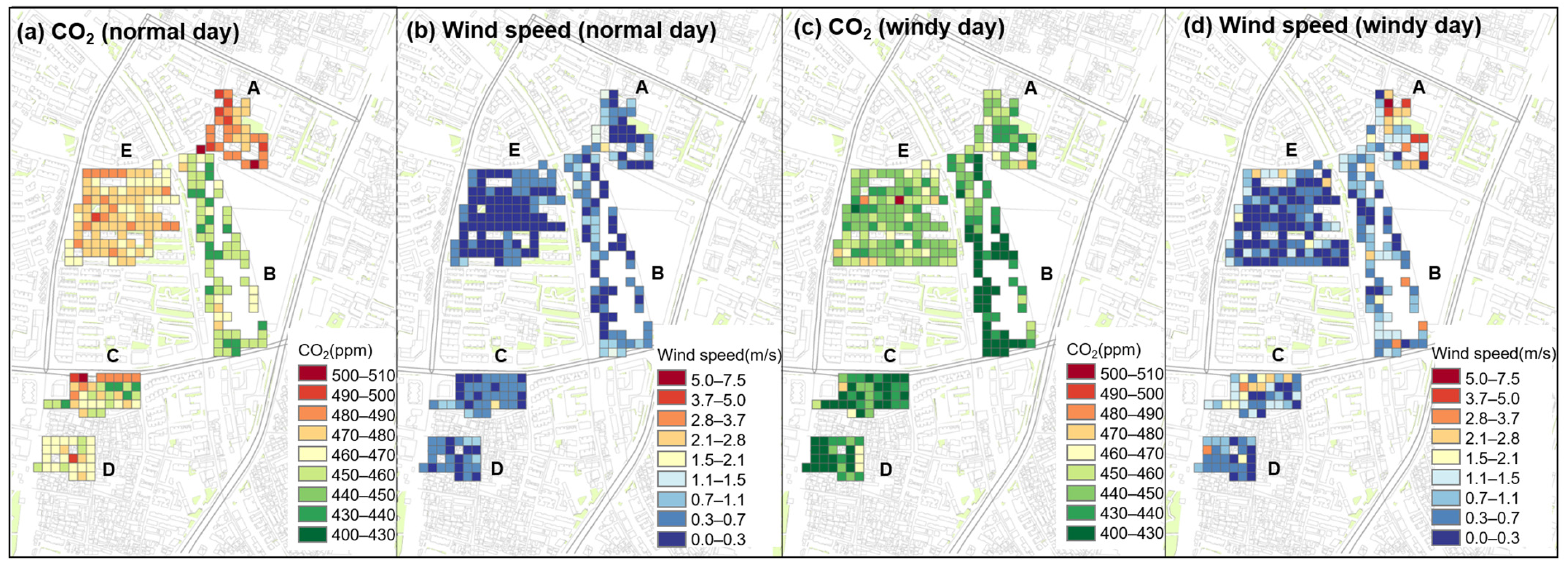
References
- Liu, J.; Zheng, X.; Chen, Y. Healthy and Low-Carbon Communities: Design, Optimization, and New Technologies. Build. Simul. 2023, 16, 1583–1585. [Google Scholar] [CrossRef]
- Goret, M.; Masson, V.; Schoetter, R.; Moine, M.-P. Inclusion of CO2 Flux Modelling in an Urban Canopy Layer Model and an Evaluation over an Old European City Centre. Atmos. Environ. X 2019, 3, 100042. [Google Scholar] [CrossRef]
- Cheng, J.; Mao, C.; Huang, Z.; Hong, J.; Liu, G. Implementation Strategies for Sustainable Renewal at the Neighborhood Level with the Goal of Reducing Carbon Emission. Sustain. Cities Soc. 2022, 85, 104047. [Google Scholar] [CrossRef]
- Kinnunen, A.; Talvitie, I.; Ottelin, J.; Heinonen, J.; Junnila, S. Carbon Sequestration and Storage Potential of Urban Residential Environment—A Review. Sustain. Cities Soc. 2022, 84, 104027. [Google Scholar] [CrossRef]
- Xiao, Z.; Ge, H.; Lacasse, M.A.; Wang, L.; Zmeureanu, R. Nature-based solutions for carbon neutral climate resilient buildings and communities: A review of technical evidence, design guidelines, and policies. Buildings 2023, 13, 1389. [Google Scholar] [CrossRef]
- Estruch, C.; Curcoll, R.; Morguí, J.-A.; Segura-Barrero, R.; Vidal, V.; Badia, A.; Ventura, S.; Gilabert, J.; Villalba, G. Exploring how the heterogeneous urban landscape influences CO2 concentrations: The case study of the Metropolitan Area of Barcelona. Urban For. Urban Green. 2024, 99, 128438. [Google Scholar] [CrossRef]
- Hou, H.; Zhang, S.; Ding, Z.; Wang, Y. Temporal variation of near-surface CO2 concentrations over different land uses in Suzhou City. Environ. Earth Sci. 2016, 75, 1197. [Google Scholar] [CrossRef]
- Song, T.; Wang, Y.; Sun, Y. Estimation of carbon dioxide flux and source partitioning over Beijing, China. J. Environ. Sci. 2013, 25, 2429–2434. [Google Scholar] [CrossRef]
- Wu, K.; Davis, K.J.; Miles, N.L.; Richardson, S.J.; Lauvaux, T.; Sarmiento, D.P.; Balashov, N.V.; Keller, K.; Turnbull, J.; Gurney, K.R.; et al. The role of emissions and meteorology in driving CO2 concentrations in urban areas. Environ. Res. Lett. 2022, 17, 074035. [Google Scholar] [CrossRef]
- Park, M.S.; Joo, S.J.; Lee, C.S. Effects of an urban park and residential area on the atmospheric CO2 concentration and flux in Seoul, Korea. Adv. Atmos. Sci. 2013, 30, 503–514. [Google Scholar] [CrossRef]
- Ueyama, M.; Ando, T. Diurnal, weekly, seasonal, and spatial variabilities in carbon dioxide flux in different urban landscapes in Sakai, Japan. Atmos. Chem. Phys. 2016, 16, 14727–14740. [Google Scholar] [CrossRef]
- Wang, Q.; Imasu, R.; Arai, Y.; Ito, S.; Mizoguchi, Y.; Kondo, H.; Xiao, J. Sub-daily natural CO2 flux simulation based on satellite data: Diurnal and seasonal pattern comparisons to anthropogenic CO2 emissions in the Greater Tokyo Area. Remote Sens. 2021, 13, 2037. [Google Scholar] [CrossRef]
- Di Martino, R.M.R.; Gurrieri, S. Theoretical principles and application to measure the flux of carbon dioxide in the air of urban zones. Atmos. Environ. 2022, 288, 119302. [Google Scholar] [CrossRef]
- Christen, A.; Coops, N.C.; Crawford, B.R.; Kellett, R.; Liss, K.N.; Olchovski, I.; Tooke, T.R.; van der Laan, M.; Voogt, J.A. Validation of modeled carbon-dioxide emissions from an urban neighborhood with direct eddy-covariance measurements. Atmos. Environ. 2011, 45, 6057–6069. [Google Scholar] [CrossRef]
- Liu, M.; Zhu, X.; Pan, C.; Chen, L.; Zhang, H.; Jia, W.; Xiang, W. Spatial variation of near-surface CO2 concentration during spring in Shanghai. Atmos. Pollut. Res. 2016, 7, 31–39. [Google Scholar] [CrossRef]
- Buckley, S.M.; Mitchell, M.J.; McHale, P.J.; Millard, G.D. Variations in carbon dioxide fluxes within a city landscape: Identifying a vehicular influence. Urban Ecosyst. 2016, 19, 1479–1498. [Google Scholar] [CrossRef]
- Gao, Y.; Lee, X.; Liu, S.; Hu, N.; Wei, X.; Hu, C.; Liu, C.; Zhang, Z.; Yang, Y. Spatiotemporal variability of the near-surface CO2 concentration across an industrial-urban-rural transect, Nanjing, China. Sci. Total Environ. 2018, 631–632, 1192–1200. [Google Scholar] [CrossRef]
- Björkegren, A.; Grimmond, C.S.B. Net carbon dioxide emissions from central London. Urban Clim. 2018, 23, 131–158. [Google Scholar] [CrossRef]
- Kim, M.K.; Choi, J.-H. Can increased outdoor CO2 concentrations impact ventilation and energy in buildings? A case study in Shanghai, China. Atmos. Environ. 2019, 210, 220–230. [Google Scholar] [CrossRef]
- Sensuła, B.; Chmura, L.; Necki, J.; Zimnoch, M. Insights from the last year’s atmospheric CO2 measurements in the urban atmosphere and the natural ecosystem in Southern Poland. Geochronometria 2024, 50, 206–222. [Google Scholar] [CrossRef]
- Velasco, E.; Segovia, E.; Roth, M. High-resolution maps of carbon dioxide and moisture fluxes over an urban neighborhood. Environ. Sci. Atmos. 2023, 3, 1110–1123. [Google Scholar] [CrossRef]
- Stagakis, S.; Chrysoulakis, N.; Spyridakis, N.; Feigenwinter, C.; Vogt, R. Eddy covariance measurements and source partitioning of CO2 emissions in an urban environment: Application for Heraklion, Greece. Atmos. Environ. 2019, 201, 278–292. [Google Scholar] [CrossRef]
- Ye, H.; Li, Y.; Shi, D.; Meng, D.; Zhang, N.; Zhao, H. Evaluating the potential of achieving carbon neutrality at the neighborhood scale in urban areas. Sustain. Cities Soc. 2023, 97, 104764. [Google Scholar] [CrossRef]
- Crawford, B.; Christen, A. Spatial variability of carbon dioxide in the urban canopy layer and implications for flux measurements. Atmos. Environ. 2014, 98, 308–322. [Google Scholar] [CrossRef]
- Liu, X.; Zhang, X.; Schnelle-Kreis, J.; Jakobi, G.; Cao, X.; Cyrys, J.; Yang, L.; Schloter-Hai, B.; Abbaszade, G.; Orasche, J.; et al. Spatiotemporal characteristics and driving factors of black carbon in Augsburg, Germany: Combination of mobile monitoring and street view images. Environ. Sci. Technol. 2021, 55, 160–168. [Google Scholar] [CrossRef]
- Baur, A.H.; Thess, M.; Kleinschmit, B.; Creutzig, F. Urban climate change mitigation in Europe: Looking at and beyond the role of population density. J. Urban Plan. Dev. 2014, 140, 94–95. [Google Scholar] [CrossRef]
- Cheshmehzangi, A.; Dawodu, A. Towards a sustainable energy planning strategy: The utilisation of floor area ratio for residential community planning and design in China. Front. Sustain. Cities 2021, 3, 687895. [Google Scholar] [CrossRef]
- Wang, M.; Zhang, F.; Wu, F. Governing urban redevelopment: A case study of Yongqingfang in Guangzhou, China. Cities 2022, 120, 103420. [Google Scholar] [CrossRef]
- Ohyama, H.; Frey, M.M.; Morino, I.; Shiomi, K.; Nishihashi, M.; Miyauchi, T.; Yamada, H.; Saito, M.; Wakasa, M.; Blumenstock, T.; et al. Anthropogenic CO2 emission estimates in the Tokyo metropolitan area from ground-based CO2 column observations. Atmos. Chem. Phys. 2023, 23, 15097–15119. [Google Scholar] [CrossRef]
- Zhu, X.-H.; Lu, K.-F.; Peng, Z.-R.; He, H.-D.; Xu, S.-Q. Spatiotemporal variations of carbon dioxide (CO2) at urban neighborhood scale: Characterization of distribution patterns and contributions of emission sources. Sustain. Cities Soc. 2022, 78, 103646. [Google Scholar] [CrossRef]
- Li, B.; Cao, R.; Wang, Z.; Song, R.-F.; Peng, Z.-R.; Xiu, G.; Fu, Q. Use of multi-rotor unmanned aerial vehicles for fine-grained roadside air pollution monitoring. Transp. Res. Rec. 2019, 2673, 169–180. [Google Scholar] [CrossRef]
- Park, C.; Jeong, S.; Park, H.; Kim, Y. Challenges in monitoring atmospheric CO2 concentrations in Seoul using low-cost sensors. Asia-Pac. J. Atmos. Sci. 2021, 57, 547–553. [Google Scholar] [CrossRef]
- Lu, K.F.; He, H.D.; Wang, H.W.; Li, X.B.; Peng, Z.R. Characterizing temporal and vertical distribution patterns of traffic-emitted pollutants near an elevated expressway in urban residential areas. Build. Environ. 2020, 172, 106678. [Google Scholar] [CrossRef]
- Bansal, P.; Quan, S.J. Relationships between building characteristics, urban form and building energy use in different local climate zone contexts: An empirical study in Seoul. Energy Build. 2022, 272, 112335. [Google Scholar] [CrossRef]
- Zhang, Y.; Zhou, W.; Ding, J. Effects of the Built Environment on Travel-Related CO2 Emissions Considering Travel Purpose: A Case Study of Resettlement Neighborhoods in Nanjing. Buildings 2022, 12, 1718. [Google Scholar] [CrossRef]
- Javadpoor, M.; Sharifi, A.; Gurney, K.R. Mapping the relationship between urban form and CO2 emissions in three US cities using the Local Climate Zones (LCZ) framework. J. Environ. Manag. 2024, 370, 122723. [Google Scholar] [CrossRef]
- Cader, J.; Koneczna, R.; Olczak, P. The impact of economic, energy, and environmental factors on the development of the hydrogen economy. Energies 2021, 14, 4811. [Google Scholar] [CrossRef]
- Yin, H.; Xiao, R.; Fei, X.; Zhang, Z.; Gao, Z.; Wan, Y.; Tan, W.; Jiang, X.; Cao, W.; Guo, Y. Analyzing “economy-society-environment” sustainability from the perspective of urban spatial structure: A case study of the Yangtze River delta urban agglomeration. Sustain. Cities Soc. 2023, 96, 104691. [Google Scholar] [CrossRef]
- Zhou, L.; Dang, X.; Sun, Q.; Wang, S. Multi-scenario simulation of urban land change in Shanghai by random forest and CA-Markov model. Sustain. Cities Soc. 2020, 55, 102045. [Google Scholar] [CrossRef]
- Khajavi, H.; Rastgoo, A. Predicting the carbon dioxide emission caused by road transport using a Random Forest (RF) model combined with meta-heuristic algorithms. Sustain. Cities Soc. 2023, 93, 104503. [Google Scholar] [CrossRef]
- Fotheringham, A.S.; Crespo, R.; Yao, J. Geographical and temporal weighted regression (GTWR). Geogr. Anal. 2015, 47, 431–452. [Google Scholar] [CrossRef]
- Park, C.; Jeong, S.; Kim, C.; Shin, J.; Joo, J. Machine learning based estimation of urban on-road CO2 concentration in Seoul. Environ. Res. 2023, 231 Pt 3, 116256. [Google Scholar] [CrossRef] [PubMed]
- Jiang, Y.; Sun, Y.; Liu, Y.; Li, X. Exploring the Correlation between Waterbodies, Green Space Morphology, and Carbon Dioxide Concentration Distributions in an Urban Waterfront Green Space: A Simulation Study Based on the Carbon Cycle. Sustain. Cities Soc. 2023, 98, 104831. [Google Scholar] [CrossRef]
- National Oceanic and Atmospheric Administration (NOAA). Global Monthly Mean CO2. Available online: https://gml.noaa.gov/ccgg/trends/global.html (accessed on 30 March 2025).
- Jardim, B.; de Castro Neto, M.; Calçada, P. Urban Dynamic in High Spatiotemporal Resolution: The Case Study of Porto. Sustain. Cities Soc. 2023, 98, 104867. [Google Scholar] [CrossRef]
- Gurney, K.; Romero-Lankao, P.; Seto, K.; Hutyra, L.R.; Duren, R.; Kennedy, C.; Grimm, N.B.; Ehleringer, J.R.; Marcotullio, P.; Hughes, S.; et al. Climate change: Track urban emissions on a human scale. Nature 2015, 525, 179–181. [Google Scholar] [CrossRef]
- Sun, D.J.; Zhang, Y.; Xue, R.; Zhang, Y. Modeling carbon emissions from urban traffic system using mobile monitoring. Sci. Total Environ. 2017, 599–600, 944–951. [Google Scholar] [CrossRef]
- Teng, W.; Shi, C.; Yu, Y.; Li, Q.; Yang, J. Uncovering the spatiotemporal patterns of traffic-related CO2 emission and carbon neutrality based on car-hailing trajectory data. J. Clean. Prod. 2024, 467, 142925. [Google Scholar] [CrossRef]
- Barichivich, J.; Briffa, K.R.; Myneni, R.B.; Osborn, T.J.; Melvin, T.M.; Ciais, P.; Piao, S.; Tucker, C. Large-scale variations in the vegetation growing season and annual cycle of atmospheric CO2 at high northern latitudes from 1950 to 2011. Glob. Change Biol. 2013, 19, 3167–3183. [Google Scholar] [CrossRef]
- Park, R.; Epstein, S. Carbon isotope fractionation during photosynthesis. Geochim. Cosmochim. Acta 1960, 44, 5–15. [Google Scholar] [CrossRef]
- Francey, R.J.; Tans, P.P. Latitudinal variation in oxygen-18 of atmospheric CO2. Nature 1987, 327, 495–497. [Google Scholar] [CrossRef]
- Fujita, D.; Ishizawa, M.; Maksyutov, S.; Thornton, P.E.; Saeki, T.; Nakazawa, T. Inter-annual variability of the atmospheric carbon dioxide concentrations as simulated with global terrestrial biosphere models and an atmospheric transport model. Tellus B Chem. Phys. Meteorol. 2003, 55, 530–546. [Google Scholar] [CrossRef]
- Tian, Y.; Zuo, S.; Ju, J.; Dai, S.; Ren, Y.; Dou, P. Local Carbon Emission Zone Construction in the Highly Urbanized Regions: Application of Residential and Transport CO2 Emissions in Shanghai, China. Build. Environ. 2024, 247, 111007. [Google Scholar] [CrossRef]
- Roth, M.; Jansson, C.; Velasco, E. Multi-year energy balance and carbon dioxide fluxes over a residential neighbourhood in a tropical city. Int. J. Climatol. 2017, 37, 2679–2698. [Google Scholar] [CrossRef]
- Bezyk, Y.; Sówka, I.; Górka, M. Assessment of Urban CO2 Budget: Anthropogenic and Biogenic Inputs. Urban Clim. 2021, 39, 100949. [Google Scholar] [CrossRef]
- Li, Z.; Chen, X.; Shen, Z.; Fan, Z. Evaluating Neighborhood Green-Space Quality Using a Building Blue–Green Index (BBGI) in Nanjing, China. Land 2022, 11, 445. [Google Scholar] [CrossRef]
- Grange, S.K.; Rubli, P.; Fischer, A.; Brunner, D.; Hueglin, C.; Emmenegger, L. The ZiCOS-M CO2 sensor network: Measurement performance and CO2 variability across Zurich. Atmos. Chem. Phys. 2025, 25, 2781–2806. [Google Scholar] [CrossRef]
- Zhang, X.; Huang, H.; Tu, K.; Li, R.; Zhang, X.; Wang, P.; Li, Y.; Yang, Q.; Acerman, A.C.; Guo, N.; et al. Effects of plant community structural characteristics on carbon sequestration in urban green spaces. Sci. Rep. 2024, 14, 7382. [Google Scholar] [CrossRef]
- Li, J.; Zhang, L.; Yu, H.; Zhu, Y. Research on Carbon Dioxide Computational Fluid Dynamics Simulation of Urban Green Spaces under Different Vegetation Spatial Layout Morphologies. Processes 2024, 12, 1931. [Google Scholar] [CrossRef]
- Chen, W.; Tan, Z.; Wu, Y.; Biljecki, F.; Liao, S.; Zhou, Q.; Li, H.; Zheng, Y.; Gao, F. Decarbonizing Megacities: A Spatiotemporal Analysis Considering Inter-City Travel and the 15-Minute City Concept. Cities 2024, 152, 105252. [Google Scholar] [CrossRef]
- Zhao, D.; Cai, J.; Xu, Y.; Liu, Y.; Yao, M. Carbon Sinks in Urban Public Green Spaces under Carbon Neutrality: A Biblio-metric Analysis and Systematic Literature Review. Urban For. Urban Green. 2023, 86, 128037. [Google Scholar] [CrossRef]
- Khanpoor-Siahdarka, M.; Masnavi, M.R. Assessment of Community Gardens’ Role in Mitigating Air Pollution and Expanding Social Opportunities: Lessons from a Neighborhood with Limited Green Infrastructure in Tehran City. Energy Nexus 2025, 17, 100363. [Google Scholar] [CrossRef]
- Motlagh, S.H.B.; Pons-Valladares, O.; Hosseini, S.M.A. City-Scale Model to Assess Rooftops Performance on Air Pollution Mitigation; Validation for Tehran. Build. Environ. 2023, 244, 110746. [Google Scholar] [CrossRef]
- Buckley, S.; Connolly, C.L.; Levy, J.I.; Templer, P.H.; Ashmore, J.; Carvalho, L.; Phillips, N.; Fabian, M.P. Carbon, Indoor Air, Energy and Financial Benefits of Coupled Ventilation Upgrade and Enhanced Rooftop Garden Installation: An Interdisciplinary Climate Mitigation Approach. Sustain. Cities Soc. 2023, 97, 104792. [Google Scholar] [CrossRef]
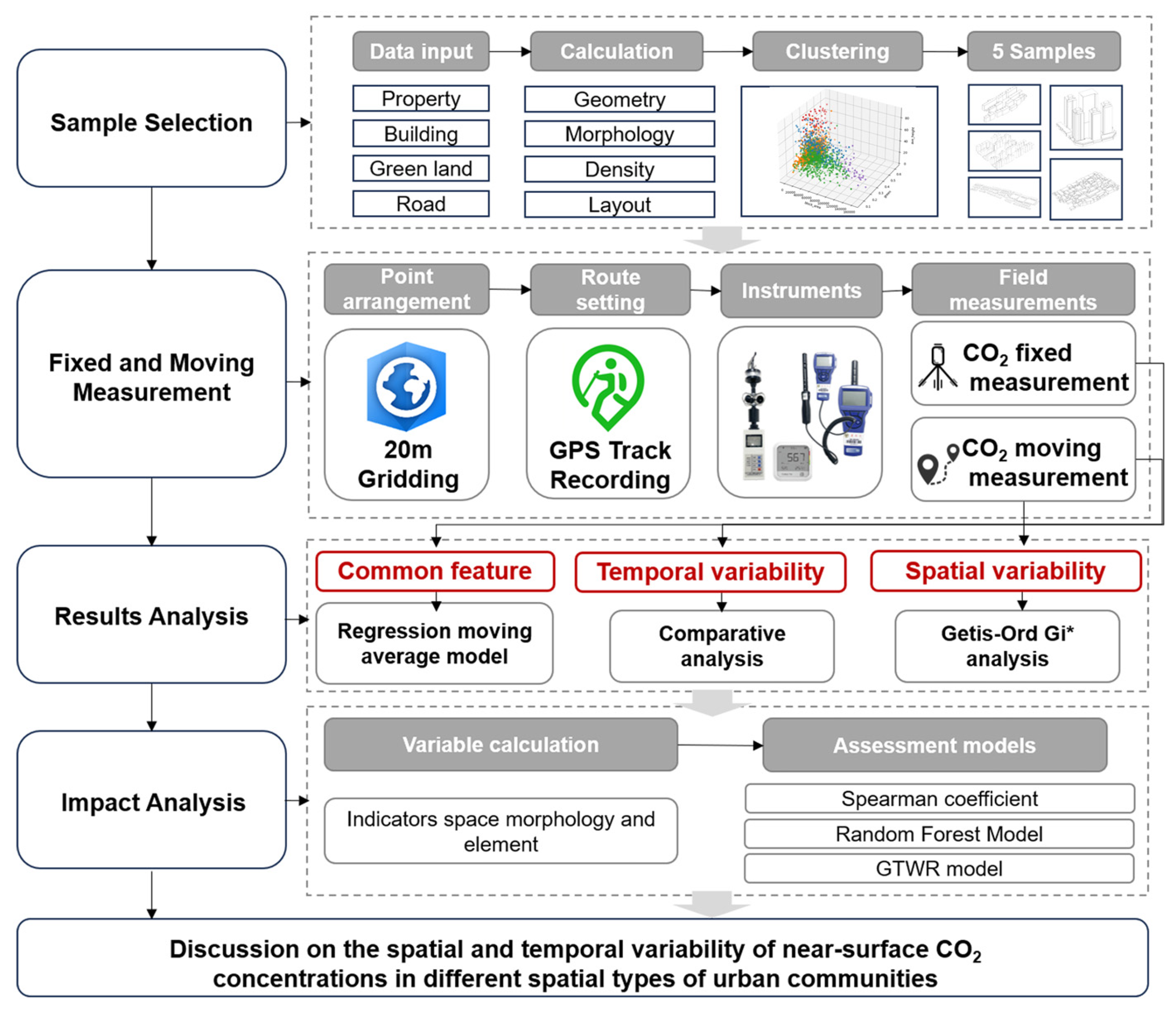

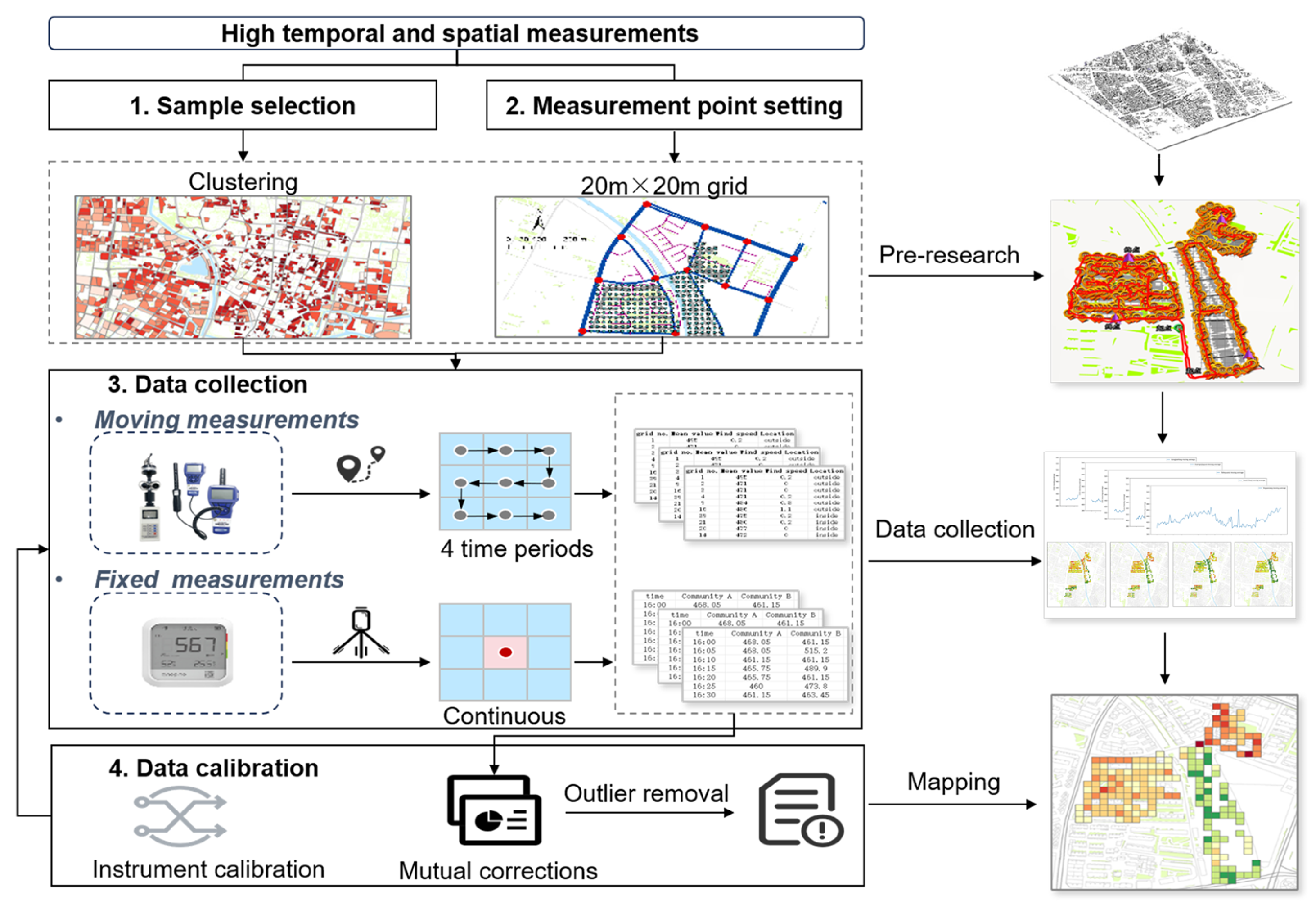


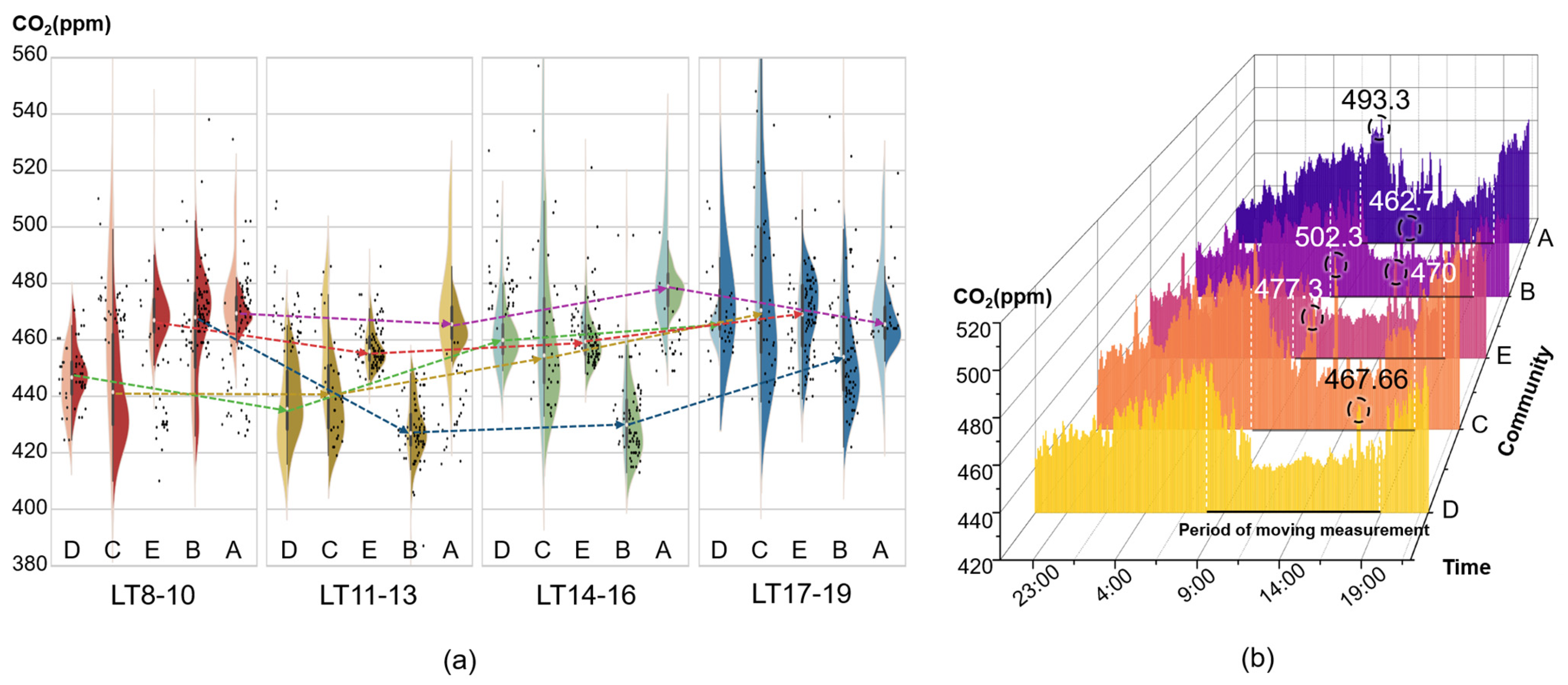
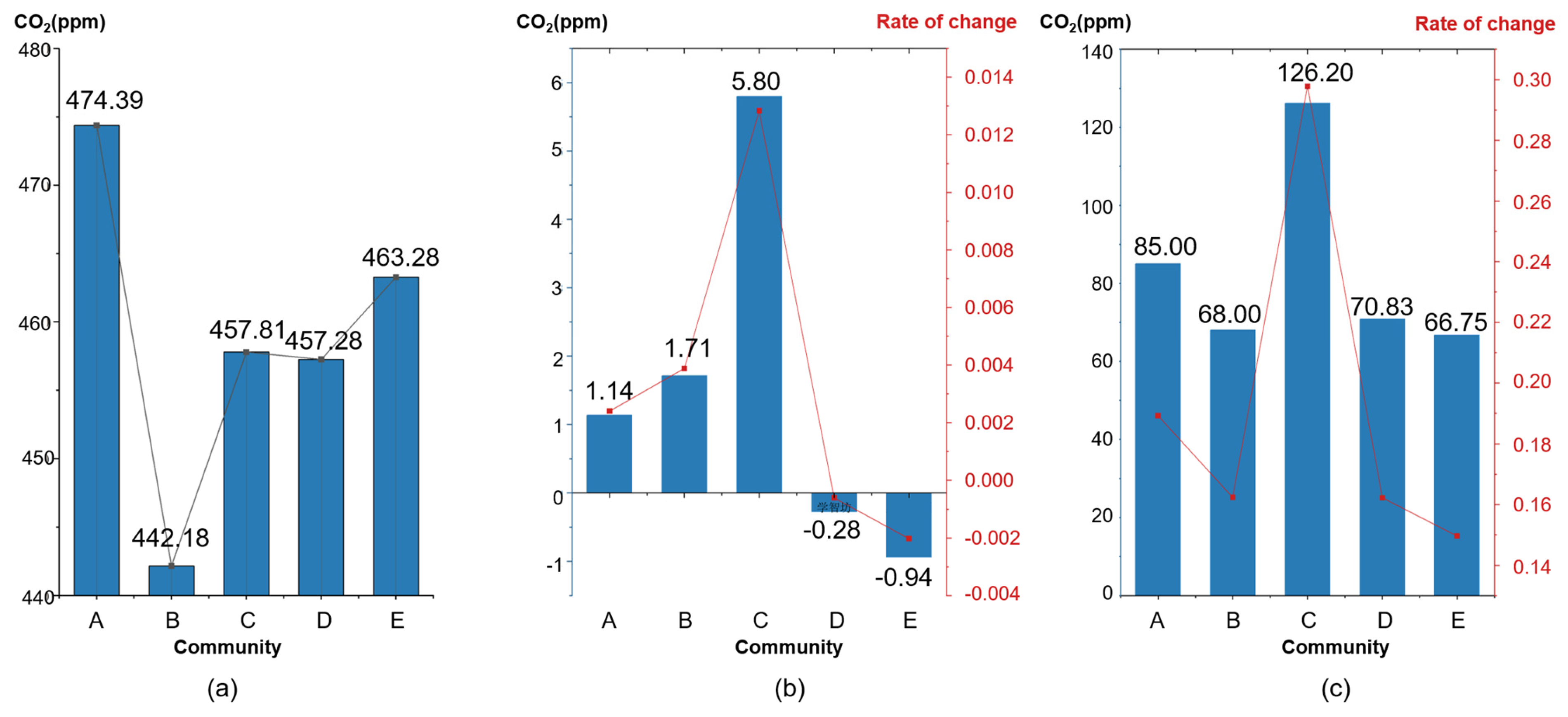

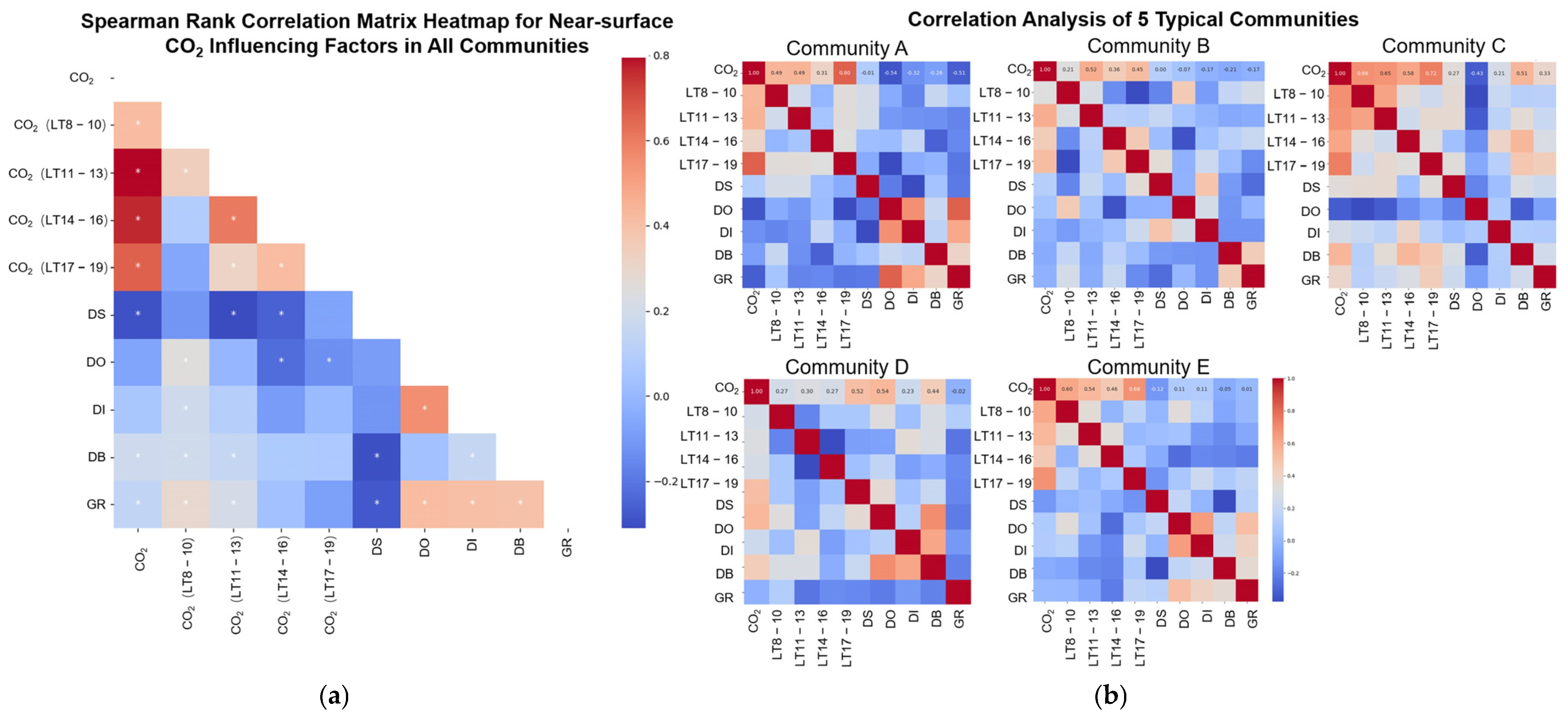
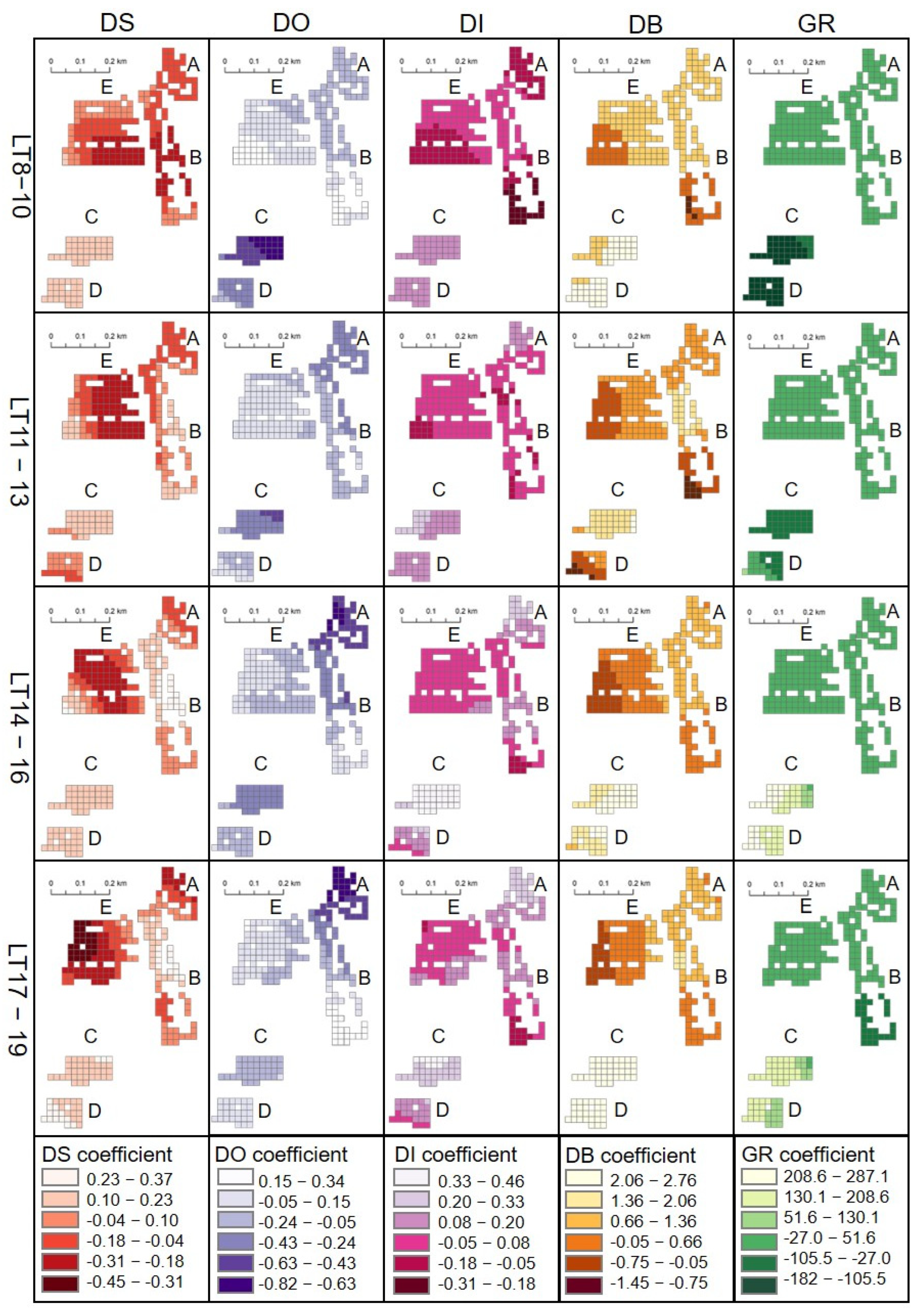
| Municipality | Area | Space Type | Measuring Height | Measurement Method | Time Resolution | Spatial Resolution | Reference |
|---|---|---|---|---|---|---|---|
| Palermo | Urban (with a nearby landfill) | Middle density urban area | 13.60 m above the ground floor | Delta Ray Isotope Ratio Infrared Spectrometer | 5 min | -- | [13] |
| Vancouver | Urban; suburban | Low density low-rise residential area | Near-surface (1.2 m above ground level) | Continuous measurements at a common point combined with vehicle moving measurements | 1 h | 20 m | [14] |
| Shanghai | Urban; suburban | High-density low-rise/high-rise residential area | Near-surface (2 m above ground level) | Multi-point urbanization gradient observation | 1 h | 5 km | [15] |
| Syracuse | Urban; suburban | High-rise commercial area; low-density low-rise residential area | Roof of building (46 m above ground level) | Continuous measurements on multiple points | 30 min | -- | [16] |
| Nanjing | Urban; suburban; rural | High-density Mixed Forms | Roof of building (110 m above ground level) | Continuous measurements on multiple points; vertical profile measurements | 1 h | -- | [17] |
| London | Urban | School area | Building walls and roofs | Continuous measurements on multiple points; vertical profile measurements | 30 min | -- | [18] |
| Shanghai | Urban | High-density high-rise residential area | Near-surface (1.2 m above ground level) | Moving measurement | 75 min | 20 m | [19] |
| Poland | urban | School area | Roof of building (20 m above ground level) | Continuous measurements on multiple points | 2 h | -- | [20] |
| Singapore | Urban | High-density low-rise residential area | Near-surface (1.7 m above ground level) | Continuous measurements at a common point combined with moving measurements | 1 h | 20 m | [21] |
| Type | Parameter | Formula | Notes |
|---|---|---|---|
| Plot indicator | Plot area | PA | 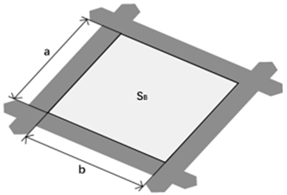 |
| Plot Perimeter | PP = ∑Li | 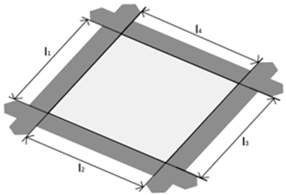 | |
| Morphological indicator | Building area | BA = ∑Si | 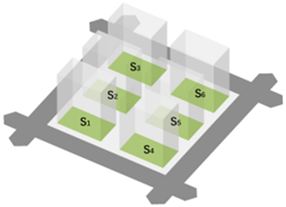 |
| Total building area | 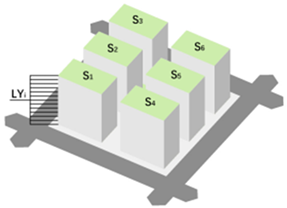 | ||
| Average height |  | ||
| Max height | HAVE + DD | 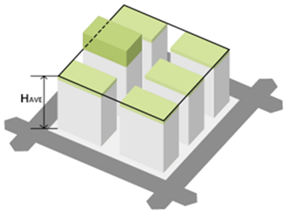 | |
| Density indicator | Building density |  | |
| Floor area ratio |  | ||
| Open space ratio |  | ||
| Layout indicator | Enclosure degree |  |
| Community | A | B | C | D | E |
|---|---|---|---|---|---|
| Plan |  | 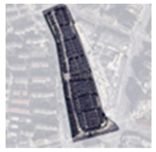 |  |  | 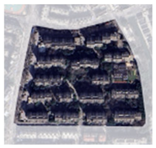 |
| Model |  |  |  |  | 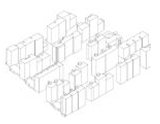 |
| Household number | 1155 | 111 | 670 | 62 | 967 |
| Building number | 12 | 21 | 15 | 62 | 15 |
| PP (m) | 533.0 | 1014.4 | 553.6 | 507.7 | 908.7 |
| PA (m2) | 12,856.2 | 32,006.3 | 13,641.6 | 15,978.8 | 50,505.8 |
| BD (m2/m2) | 0.5 | 0.5 | 0.4 | 0.6 | 0.3 |
| FAR (m2/m2) | 5.8 | 1.0 | 2.4 | 0.8 | 2.1 |
| AH (m) | 96 | 7 | 21 | 6 | 39 |
| ED (m2/m2) | 0.9 | 0.2 | 0.7 | 0.8 | 0.6 |
| OSR (m2/m2) | 0.17 | 0.03 | 0.01 | 0.02 | 0.20 |
| Type | Parametric | Instrument Type | Range | Accuracy | Resolution | Unit | Sampling Time | Time Resolution | Spatial Resolution |
|---|---|---|---|---|---|---|---|---|---|
| Fixed | CO2 concentration | Qing Ping | 400–9999 | ±15% | 1 | ppm | 30 s | 10 min | -- |
| Mobile | CO2 concentration | TSI-7515, TSI-7525 | 0–5000 | ±3% | 1 | ppm | 30 s | 2 h | 20 m |
| Air velocity | PLC-16025 | 0.8–30 | ±2% | 0.01 | m/s | 30 s | 2 h | 20 m |
| MODEL | R2 | R2 Adjusted | AICc | Spatiotemporal Distance Ratio |
|---|---|---|---|---|
| GTWR | 0.512 | 0.509 | 9562 | 0.642 |
| GWR | 0.243 | 0.239 | 9885.63 | -- |
| OLS | 0.055 | -- | 10,055.64 | -- |
| CO2 (Average) | CO2 (LT 8–10) | CO2 (LT 11–13) | CO2 (LT 14–16) | |
|---|---|---|---|---|
| PP | −0.3 | 0.1 | −0.5 | −0.9 * |
| PA | −0.4 | 0.0 | −0.3 | −0.8 |
| BD | −0.6 | −0.2 | −0.3 | 0.2 |
| FAR | 0.8 | 0.4 | 0.5 | 0.4 |
| AH | 0.9 * | 0.7 | 0.7 | 0.3 |
| ED | 0.5 | 0.9 * | 0.6 | −0.1 |
Disclaimer/Publisher’s Note: The statements, opinions and data contained in all publications are solely those of the individual author(s) and contributor(s) and not of MDPI and/or the editor(s). MDPI and/or the editor(s) disclaim responsibility for any injury to people or property resulting from any ideas, methods, instructions or products referred to in the content. |
© 2025 by the authors. Licensee MDPI, Basel, Switzerland. This article is an open access article distributed under the terms and conditions of the Creative Commons Attribution (CC BY) license (https://creativecommons.org/licenses/by/4.0/).
Share and Cite
Wu, Y.; Zheng, Y.; Liu, J.; Yang, Q.; Shi, B.; Guan, C.; Deng, W. Spatial and Temporal Variability of Near-Surface CO2 and Influencing Factors in Urban Communities. Land 2025, 14, 888. https://doi.org/10.3390/land14040888
Wu Y, Zheng Y, Liu J, Yang Q, Shi B, Guan C, Deng W. Spatial and Temporal Variability of Near-Surface CO2 and Influencing Factors in Urban Communities. Land. 2025; 14(4):888. https://doi.org/10.3390/land14040888
Chicago/Turabian StyleWu, Yueyue, Yi Zheng, Jialei Liu, Qingxin Yang, Beixiang Shi, Chenghe Guan, and Wanxin Deng. 2025. "Spatial and Temporal Variability of Near-Surface CO2 and Influencing Factors in Urban Communities" Land 14, no. 4: 888. https://doi.org/10.3390/land14040888
APA StyleWu, Y., Zheng, Y., Liu, J., Yang, Q., Shi, B., Guan, C., & Deng, W. (2025). Spatial and Temporal Variability of Near-Surface CO2 and Influencing Factors in Urban Communities. Land, 14(4), 888. https://doi.org/10.3390/land14040888






